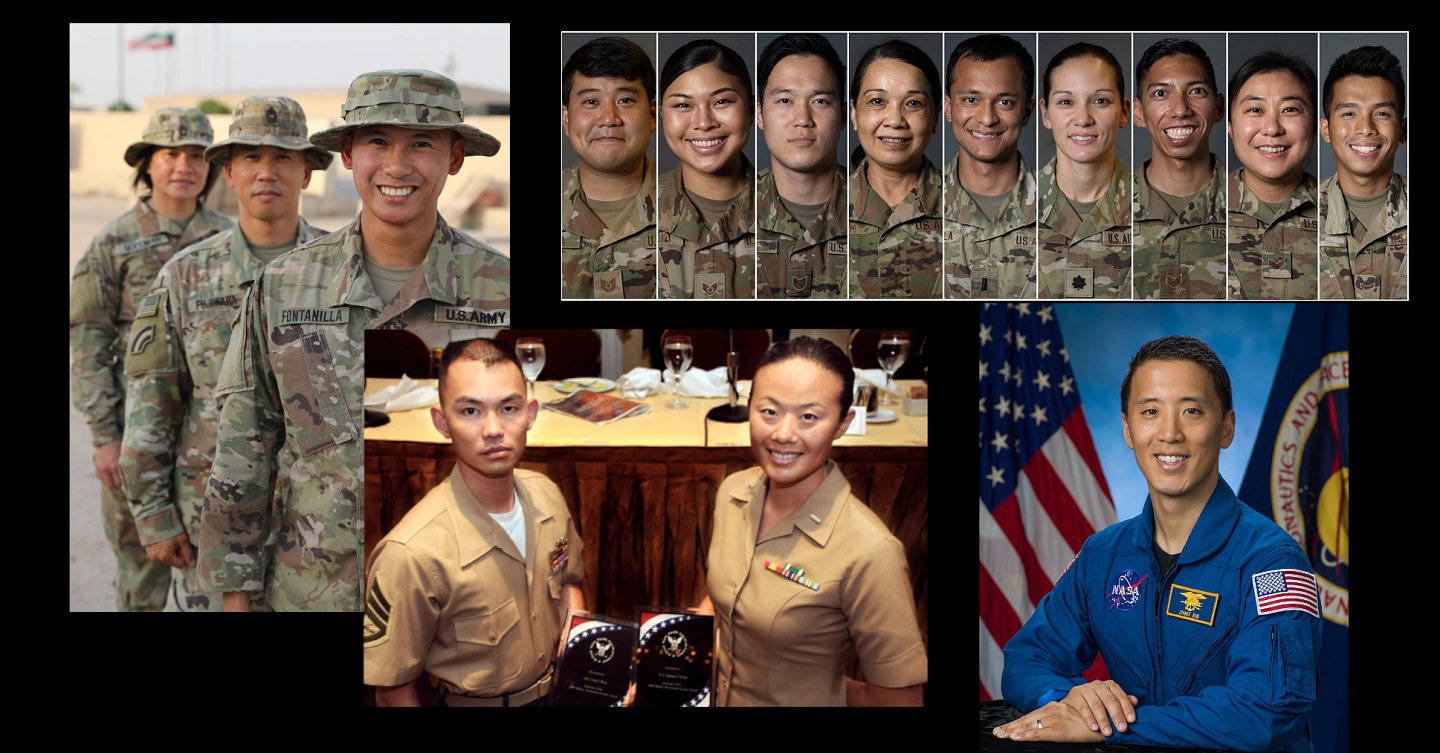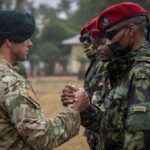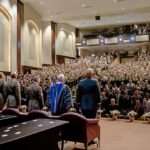
In survey results from 2017, almost a quarter of Asian American service members reported experiencing racial or ethnic harassment or discrimination in the preceding year alone.
As COVID-19 spread among the U.S. population, violent attacks against Asians and Asian Americans in the U.S. rose in response to rhetoric about the Chinese origins of the virus. Though fortunately less frequent, examples of this vitriol also emerged among U.S. service members and against an Asian American veteran. Even prior to COVID-19, Asian American service members reported higher levels of racial harassment and discrimination than white service members on the military’s Workplace Equal Opportunity Survey. In survey results from 2017, almost a quarter of Asian American service members reported experiencing racial or ethnic harassment or discrimination in the preceding year alone. Since they are the fastest growing minority demographic in the United States, the inclusion of Asian Americans in the military is both a strategic human capital challenge and an opportunity that warrants immediate attention. Civilian and military senior leaders should consider three issues to recognize and benefit from Asian American service members as a strategic human capital asset: programs, personnel, and culture.
Programs: Where Are the Human Capital Initiatives to Support the Indo-Pacific Strategic Focus?
The 2022 National Defense Strategy identifies competition with China as the top strategic priority. As a result, understanding national interests and cultures in the Indo-Pacific region is essential to countering China’s influence and maintaining critical partnerships.
The shift in priorities to the Indo-Pacific region following an extended focus on the Middle East means the U.S. may not yet have the regional and cultural insight needed across the force or strategic empathy for key actors. In the office of the Undersecretary of Defense for Personnel and Readiness, short tenures and vacancies since the George W. Bush administration have left gaps in the alignment of human capital initiatives with strategic priorities. Lessons from the Middle East and Afghanistan can help the Department of Defense (DoD) anticipate demand and begin preparing in the competition phase, well before a conflict, rather than waiting until conflict is underway to recognize the human capital needs. For example, the 09L military linguist program in the Army addressed the need for heritage foreign language speakers in the Middle East. Recruiting Asian heritage language speakers now instead of later would help ensure cultural and linguistic expertise is available when it’s needed. The Air Force is already doing so with its Language-Enabled Airmen Program.
Lessons from the Afghanistan-Pakistan (AfPak) Hands program can be similarly instructive. Based in part on the Department of State’s China Hands program in the 1940s, AfPak Hands established a cadre of military personnel with language, cultural, regional, and advisory skills to engage leaders at the operational and strategic levels in theater. The program demonstrated both successes and shortcomings in its ten years of implementation, offering lessons for talent management. General Martin Dempsey initiated an Asia-Pacific (APAC) version of the program during his tenure as Chairman of the Joint Chiefs of Staff, but APAC Hands barely lifted off before fading entirely.
In another initiative, the Defense Language and National Security Office developed the Regional Proficiency Assessment Tool to help commanders identify personnel within their commands with regional knowledge that may not be evident from their personnel records. This tool is a self-report of experiences, language proficiencies, and related skills in fifteen world regions. However, in privileging formal education and assignments over informal learning and heritage experiences, the approach raises questions about its relevance for Asian Americans and other heritage groups. In addition, relatively few service members completed it, in spite of a Government Accountability Office review indicating it would be implemented in 2015.
The role of Asian Americans is also important in strategic messaging. China seeks to exploit rifts in U.S. race relations for promotion of communism and to undermine U.S. credibility on human rights issues. Attacks on Asian Americans in the U.S. have the potential to bolster Chinese information operations campaigns if left unanswered.
Personnel: Why Are Asian Americans Underrepresented in the Military?
Asian Americans are somewhat under-represented in the U.S. military, comprising 4.4% of active-duty service members in 2018, but 6.3% of the adult U.S. population under age 65. They are similarly underrepresented in the intelligence community at only 4.3% of the workforce. Their representation among the officer corps is concerning. While Asian Americans are 9.7% of the U.S. population with bachelor’s degrees, they are only 5.2% of officers. In other words, the percentage of officers is half of what would be expected based on the eligible population. Underrepresentation of Asian Americans at senior levels is even more stark; they are only 1.8% of General Officers or Flag Officers, resulting in low visibility of Asian American service.
Accessions of Asian American officers has improved in recent years, and retaining these young officers will be key to building a bench of more diverse senior leaders for the future. Representation of Asian Americans among the federal workforce (excluding the intelligence community) is very similar to that of the US adult population, at 6.1 and 6.3, respectively. Thus, it’s not lack of interest or public service motivation that keeps Asian Americans from serving.
Although security clearances may be more challenging for applicants with more recent family immigration history, risk-benefit considerations can be managed as a component of the risk analysis that is already part of the investigation process. Ongoing efforts at the Department of State may be instructive as they aim to improve fairness and transparency in security procedures.
Historically, the literal exclusion of Asians from the U.S. took the form of law and policy―for example, the Chinese Exclusion Act and the detention camps for Japanese Americans in WWII.
Culture: To What Extent Are National and Organizational Culture a Barrier?
National culture and organizational culture set the conditions for inclusion of Asian Americans in DoD, and Asian Americans have long struggled for inclusion into American national identity. Historically, the literal exclusion of Asians from the U.S. took the form of law and policy―for example, the Chinese Exclusion Act and the detention camps for Japanese Americans in WWII.
Exclusion of Asian Americans now takes a more nuanced form, with Asian Americans viewed as less American in measures of implicit attitudes, more popularly known as unconscious bias. Research has shown that many Americans associate “American” with “whiteness.” For example, in a test pairing national symbols with famous celebrities, researchers found that participants showed stronger implicit associations between American symbols and Kate Winslet (who is English) than Lucy Liu, even though participants consciously knew that Lucy Liu is American and Kate Winslet is not. Asian Americans themselves show this bias, unlike African Americans. Such findings have led researchers to describe U.S. national identity as “exclusionary,” with Asian Americans treated as perpetual foreigners.
This exclusionary identity is evident in DoD as well, with Asian Americans experiencing racist hazing. Such hazing may have been a contributing factor in the suicide of PFC Danny Chen in 2011. Chen killed himself during a deployment to Afghanistan after experiencing bullying within his unit, resulting in charges for eight soldiers. Even if service members experience little or no racist bullying and hazing in their units, leaders should be aware that their Asian American subordinates may be experiencing it in their personal lives, or their families may be targets. In those circumstances, military inclusion becomes even more important for the well-being of minority service members.
Inducing empathy can be a very simple way to improve this. Asking people to put themselves in the shoes of an Asian American character can help increase the inclusion of Asian Americans into notions of “us” rather than “them.” Further research is needed to determine whether such interventions have a lasting impact, but their simplicity and impact in the lab are promising.
Ensuring that the organizational culture is inclusive of Asian Americans and other minorities is important for gaining the benefits of cognitive diversity provided by multicultural service members. Specifically, accommodating the bicultural identities of many Asian Americans may provide important benefits on complex tasks with high uncertainty. Bicultural Asian Americans often engage in frame switching that allows them to apply different cultural lenses depending on the situation. These perspectives can enhance innovation and divergent problem solving, but organizations can only reap these benefits when they create climates of psychological safety for their members. This climate requires less emphasis on cognitive conformity and more tolerance of uniqueness. Benefiting from the diverse cultural perspectives Asian Americans bring thus requires leaders enable members to manage dual identities without forcing them to sacrifice or suppress one for another.
Asian Americans have much to contribute but are underrepresented in the national security workforce and have been a neglected demographic in recent discussions of diversity and inclusion in the DoD. As the U.S. focuses on China as a competitor, strategy and concepts have taken shape to better modernize, organize, and equip the joint force. Human capital should also be part of the equation. Defense leaders should make systematic efforts to improve the recruitment, retention, and inclusion of Asian Americans in the armed forces.
Allison Abbe is professor of organizational studies at the US Army War College. Her research focuses on the development of leadership, interpersonal, and intercultural skills in national security personnel. She has previously worked as a research psychologist and program manager in defense and intelligence organizations and holds a PhD in social and personality psychology.
The views expressed in this article are those of the author and do not necessarily reflect those of the U.S. Army War College, the U.S. Army, or the Department of Defense.
Photo Description: Clockwise (L-R) 40th Combat Aviation Brigade celebrates Asian American and Pacific Islander month; A graphic highlighting Asian American and Pacific Islander Heritage Month at Travis Air Force Base, California; U.S. Navy Lieutenant Commander (and former SEAL), physician, and NASA astronaut Jonny Kim; Staff Sgt. Tom S. Woo and 1st Lt. Monica J. Moon present their Federal Asian Pacific American Council Military Meritorious Service Awards.
Photo Credit: Clockwise (L-R) U.S. Army photo, Sgt. 1st Class Ryan Sheldon; U.S. Air Force graphic by Hun Chustine Minoda; NASA photo by Bill Stafford; USMC photo by Cpl. Karim Delgado





The problem with such things as “diversity promotion,” today, this is the fact that initiatives of this “revolutionary change” nature have now come to be associated with the broader “revolutionary” political, economic, social and/or value “change” initiatives being undertaken by certain governments — whose primary goal is to provide that the states and societies of the world (to include one’s own) might be made to better interact with, better provide for and better able to benefit from such things as capitalism, globalization and the global economy. (Thought, by these such governments, to be A/THE national security requirement of today?)
Thus it is this such unfortunate association — with the broader, market-based, governmental “revolutionary change” initiatives described above — which gives such things as “diversity promotion” (etc., etc., etc.) today, a “bad name?”
This, in certain circles, where (a) these broad “revolutionary change” initiatives are (b) significantly opposed?
In order to properly deal with the “diversity promotion” problems that I identify in my initial comment above, perhaps the following thoughts — from the “Conclusion” of the “Summary” section (see Page xxiii) of LTG (ret.) Charles Cleveland’s 2020 Rand paper “The American Way of Irregular War: An Analytical Memoir” — perhaps these such thoughts should be seen by a much larger audience:
“An American way of irregular war will reflect who we are as a people, our diversity, our moral code, and our undying belief in freedom and liberty. It must be both defensive and offensive. Developing it will take time, require support from the American people through their Congress, and is guaranteed to disrupt the status quo and draw criticism. It will take leadership, dedication, and courage. It is my hope that this study encourages, informs, and animates those with responsibility to protect the nation to act. Our adversaries have moved to dominate in the space below the threshold of war. It will be a strategy built around the American way of irregular war that defeats them.”
If the U.S./the West’s opponents are “moving to dominate the space below the threshold of war,” then, as LTG (ret.) Cleveland notes above, American “diversity” (etc.) — if it is allowed to grow, thrive and prosper — will be necessary to (a) defeat these such opponents who (b) have “moved to dominate the space below the threshold of war?”
In my second comment above, I note that LTG (ret.) Cleveland — in his “The American Way of Irregular War” — seems to suggest that such things as America’s “diversity” plays a key role in the U.S. being able to successfully pursue its irregular warfare goals.
In GEN Votel, et. al’s, “Unconventional Warfare in the Gray Zone” (therein, see the “Doctrine” section) a similar claim seems to be made — re: unconventional warfare in this case — as relates to the U.S. being known for supporting “unfortunate population groups who seek alternatives to a life of fear, oppression, and injustice:”
“Advocates of UW first recognize that, among a population of self-determination seekers, human interest in liberty trumps loyalty to a self-serving dictatorship, that those who aspire to freedom can succeed in deposing corrupt or authoritarian rulers, and that unfortunate population groups can and often do seek alternatives to a life of fear, oppression, and injustice. Second, advocates believe that there is a valid role for the U.S. Government in encouraging and empowering these freedom seekers when doing so helps to secure U.S. national security interests.”
If we consider that — in the U.S. and elsewhere — those “unfortunate population groups who seek alternatives to a life of fear, oppression, and injustice,” these folks are often minority groups and/or women,
Then, in consideration of this such understanding — and as relates to the U.S.’s both irregular and unconventional warfare capabilities noted by LTG (ret.) Cleveland and GEN (ret.) Votel, et. al above — must not such things as “diversity promotion” be seen as being critically essential to the ability of the U.S. to successfully do both irregular and unconventional warfare — today and going forward?
Something for those who — for various reasons — would stand against such things as “diversity promotion” to (a) better understand and to (b) more seriously consider?
Great overview of Asians in the military.
Our China plan needs work and effort.